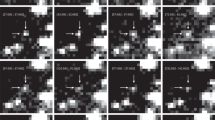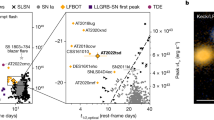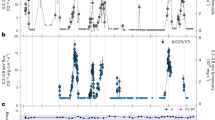Abstract
TEMPORAL structure down to the millisecond time scale has been observed in the X-ray emission of Cyg X-1 (ref. 1). This has been interpreted as evidence of instabilities in the accretion disk surrounding a black hole2–4, lasting for approximately the orbital period of the infalling matter. We report here observations of modulated optical emission from this source with a period of ∼ 83 ms. The modulated emission was detected in two sets of obserations as transient events lasting ∼ 10 min. This is the first evdence of strong emission at optical wavelengths from the C-ray source in the Cyg X-1-HDE226868 system.
Similar content being viewed by others
References
Rothschild, R., Boldt, E., Holt, S., and Serlemitsos, P., Astrophys. J. Lett., 189, L13 (1974).
Pringle, J. E., and Rees, M. J., Astr. Astrophys., 21, 1 (1972).
Shakura, N. I., and Sunyaev, R. A., Astr. Astrophys., 24, 337 (1973).
Thorne, K. S., and Price, R. H., Astrophys. J. Lett., 195, L101 (1975).
Gursky, H., et al., IAU Circ, No. 2778, May 9 (1975).
Author information
Authors and Affiliations
Rights and permissions
About this article
Cite this article
AURIEMMA, G., CARDINI, D., COSTA, E. et al. Transient short time periodicities in the optical enission from Cyg X-1. Nature 259, 27–29 (1976). https://doi.org/10.1038/259027a0
Received:
Accepted:
Issue Date:
DOI: https://doi.org/10.1038/259027a0
- Springer Nature Limited
This article is cited by
-
Is there a black hole among the black-hole candidates?
Journal of Astrophysics and Astronomy (1989)
-
Second catalogue of X-ray sources
Astrophysics and Space Science (1982)
-
A search for rapid optical periodicities from Cyg X-l
Nature (1978)
-
CygX-1/A candidate of the black hole
Space Science Reviews (1977)





